The Doyne Family
Anne Catherine (Doyne) Carter
26 December 1850, in Ireland
Philip Walter
Doyne
Emily
Sophia (Richards) Doyne
Willoughby
Carter on 9 January 1884, in Poole
district, Dorset, England
21 September 1887
1881:
East
Street, Corfe Castle, Dorset
Charles Goddard Doyne
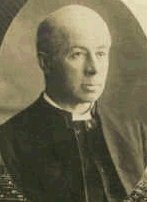 |
|
Charles Goddard Doyne
|
26 August 1852, in Enniscorthy,
county Wexford, Ireland
Philip Walter Doyne
Emily
Sophia (Richards) Doyne
Marlborough College, then Trinity
College, Cambridge. Charles graduated B.A. in 1875 and M.A. in 1880.
Marlborough College register p211
(1905)
Doyne, Charles
Goddard, s. of the late Rev. P.W. Doyne, care of Mrs. Doyne,
Monant, Torquay, b. Aug. 26, 1852; l. Xmas 1870. B 1
Rev. C.G. Doyne, Branksome
Vicarage, Bournemouth
Trin. Coll. Camb.; B.A. 1874; M.A. 1880; H.O. 1875; V. of Branksome
1882
Alumni Cantabrigienses by John Venn (1940-54)
transcribed at A
Cambridge Alumni Database
Doyne, Charles
Goddard.
Adm. pens. at TRINITY, July 8, 1871. S. of Philip Walter, clerk, of The
Cottage, Wraxall. B. Aug. 26, 1852, at Enniscorthy, Co. Wexford. School,
Marlborough. Matric. Mich.. 1871; B.A. 1875; M.A. 1880. Ord. deacon, 1875;
priest (Oxford) 1876; C. of Hambledon, 1875-7. C. of Longbridge Deverill,
Wilts., 1877-80. C. of Corfe Castle, Dorset, 1880-2. V. of Branksome,
1882-1909. This Doyne family claims to derive from an ancient Irish
[p.333] Sept, whose chieftains formerly ruled over the territory comprised
in the present Queen's Co. Died Mar. 19, 1909, aged 56, at St Aldhelm's
Clergy House, Branksome. Brother of Philip V. (1883). (Burke, L.G.
of Ireland, which gives date of birth Oct. 26; Crockford;
Scott, MSS.; Marlborough
Coll. Reg.)
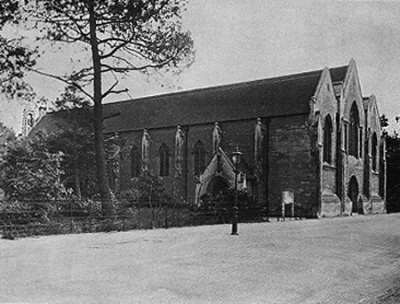 |
|
St Aldhelm's Church, Branksome, Dorset
|
Clergyman. Charles was ordained
deacon in 1875 and priest in 1876. He was curate of Hambledon,
Buckinghamshire from 1875-7, curate of Longbridge Deverill, Wiltshire
1877-80, curate of Corfe Castle, Dorset from 1880-2 and vicar of Branksome,
Dorset from 1882 until his death in 1909. Charles was the third vicar of All
Saints Branksome which at the time used St Aldhelm's school as a mission
church. He initiated the building of the new St Aldhelm's church. The
foundation stone of the building, designed by G.F. Bodley, was laid on 2
December 1892, and the first part of the church was consecrated on 11 July
1894 by Bishop John Wordsworth of Salisbury. Charles died before the church
was fully completed. The church as it stands today was completed in 1912,
but the complete design, including a large tower, has never been
implemented.
19 May 1909, at St Aldhelm's
Clergy House, Branksome, Poole, Dorset, aged 56
1871:
The Vicarage, Corfe Castle, Dorset
1881:
East
Street, Corfe Castle, Dorset
1901: All Saints Vicarage,
Western Road, Parkstone, Dorset
Charlotte Sophia Mary (Doyne) Finch
30 December 1855, in Ireland
Philip Walter
Doyne
Emily
Sophia (Richards) Doyne
Arthur Edward Finch on 15 June 1881
in Farnham
district, Hampshire or Surrey, England
1929, in Wycombe
district, Buckinghamshire, England, aged 73
1881:
East
Street, Corfe Castle, Dorset
1901: All Saints Vicarage,
Western Road, Parkstone, Dorset
1914: Abbey Cottage, Well End, Buckinghamshire (Little
Marlow on-line)
Emily Elizabeth (Doyne) Adams
24 March 1854, in Ireland
Philip Walter
Doyne
Emily
Sophia (Richards) Doyne
George
Edward D'Arcy Adams on 1 June 1876, in All Saints, Wraxall, Somerset.
George D'Arcy Adams is recorded as a bachelor, aged 30, a doctor of medicine
from West Town in the parish of Backwell, the son of George Adams, a
surgeon. Emily Elizabeth Doyne is listed as a spinster, aged 22, of Wraxall
Cottage, the daughter of Philip Walter Doyne, a clerk in holy orders.
The Medical times and gazette 10 June 1876
MARRIAGES.
ADAMS-DOYNE,- On
June 1, at the parish church, Wraxall, George Edward d'Arcy Adams, M.D.,
of West Town, Backwell, Somerset, to Emily Elizabeth Doyne, second
daughter of the late Rev. P.W. Doyne.
about 1945
1881:
1
Clifton Gardens, London, Middlesex
1891: 1 Clifton Gardens,
Paddington, London
1901: 1 Clifton Gardens,
Paddington, London
Eric Dermot Doyne
4 February 1903, in Beckley,
Oxfordshire, England
10 March 1903, in Beckley,
Oxfordshire, England
Philip
Valentine
Doyne
Mary Elizabeth (Johnson) Doyne
1911: Beckley Vicarage, Beckley, Oxfordshire
Faith (Doyne) Herbert
17 April 1893, in Horningsham,
Wiltshire, England
12 May 1893, in St John the
Baptist, Horningsham, Wiltshire, England. Faith Doyne is the daughter of
Philip Valentine Doyne, a clerk in holy orders residing in Horningsham, and
Mary Elizabeth.
Philip Valentine Doyne
Mary Elizabeth (Johnson) Doyne
Charles Ivan Herbert on 7 December
1922, in Holy Trinity, Headington Quarry, Oxfordshire, England. At the time
of his marriage, Charles was an army officer based with the Small Arms
School Corps in Hythe, Kent.
1901: Beckley Vicarage, Beckley, Oxfordshire
1911: Beckley Vicarage, Beckley, Oxfordshire
Herbert William Gibbs Doyne
12 January 1861, in Torre, Devon,
England
Philip Walter Doyne
Emily
Sophia (Richards) Doyne
Rosa Pattie Pooler in 1893, in
Newport
district, Shropshire, England. Rose was born in 1871, in Church Aston,
Shropshire, the daughter of Henry Pooler and Annie Tregarthen Mitchell. Rosa
died in 1939, in Milton
district, Kent, aged 68
1881:
Cheswell,
Lonford, Shropshire
Naval Surgeon. Herbert
served in the Royal Navy for 35 years, reaching the rank of Surgeon
Rear-Admiral.
Herbert was admitted L.R.C.P. & S. Edin. in 1884 (Edinburgh Medical Journal June 1884 p1148)
and entered the Royal Navy as surgeon on 21 August 1884 (London Gazette 26 August 1884 p3870). He
joined the flag ship Duke of Wellington
stationed in Portsmouth, as a supernumerary surgeon borne for service at the
Royal Navy Hospital in Haslar, Hampshire. Herbert joined the flag ship Royal Adelaide on 29 October 1884 (Navy List 1884 p234) as a supernumerary
surgeon "for disposal". On 1 January 1885, Herbert joined the flag ship Agincourt as surgeon, then on 14 April
1885 he transferred to the flag ship Bacchante
bound for the East Indies (Navy List 1886 p197), and on 10 February
1890, he joined the Colossus
stationed in the Mediterranean (Navy List 1891 p211). In March 1893, we see
Herbert, then on the President (a
training ship) appointed to the Royal Marine Depot in Walmer, Kent (British Medical Journal 18 March 1893 p610),
then
in March 1895, he joined the Crescent.
Herbert was promoted to Staff Surgeon on 21 August 1896 (London Gazette 25 August 1896 p4817), a
normal promotion after twelve years of service, then he was appointed to the
Boscawen, additional, for the Minotaur on 19 November 1896 (British Medical Journal 14 November 1896 p1483),
then to the Hawke on 27 October
1897 (British
Medical Journal 6 November 1897 p1380), the Collingwood
on 1 November 1898 (British Medical Journal 5 November 1898 p1465),
the Lion on 3 October 1899 (British Medical Journal 16 September 1899 p755)
and then the Centurion, bound for
Yokohama, on 1 January 1900 (British Medical Journal 6 January 1900 p55).
Herbert was made Fleet Surgeon on 21 August 1900 (London Gazette 11 December 1903 p8195), and
on 20 June 1904 he was appointed to the President
"for the Royal Naval Rendezvous, etc." (British Medical Journal 25 June 1904 p1518).
In
August 1906, Herbert was appointed to the Bulwark,
(Lancet 25 August 1906 p521) then he joined
the King Edward VII at its
recommissioning on 5 March 1907 (British Medical Journal 23 February 1907 pS99).
On
13 April 1909, Herbert was assigned additional to the President,
docked in London, for three months' study at West London Hospital (British Medical Journal 17 April 1909 p181),
then
to the Devonport Yard on 1 September 1909 (British Medical Journal 4 September 1909 p214).
He
went to the Abermarle in 1912 "for
general staff duties on commissioning" (British Medical Journal November 1912 pS561).
Herbert
was promoted to Deputy Surgeon-General on 6 May 1913 (London Gazette 17 June 1913 p4307). In July
1917, Herbert was appointed to the Royal Navy Barracks in Chatham, Kent (British
Medical Journal 14 July 1917 pS15). He was promoted to
Surgeon Rear-Admiral on 13 September 1919 (London Gazette 19 September 1919 p11685).
He retired the next day, on 14 September 1919 (London Gazette 23 September 1919 p11799)
Herbert joined the British Medical Association in 1885, and at the annual
meeting at Oxford in 1904 served as honorary secretary of the Navy, Army,
and Ambulance Section (Yearbook of the scientific and learned societies of
Great Britain, 1904, p254)
Herbert bought the mansion "Rose
Hill" in Sittingbourne, Kent. He sold parts of the grounds to the Watling
Trust for use as a cricket and hockey ground. The house was sold on his
death and eventually fell into disrepair and was demolished in the 1960s.
The ruins of the house can still be seen in the woodland overlooking the
cricket field in Sittingbourne. (Historical
Research Group of Sittingbourne)
23 January 1936, at the Royal Naval
Hospital, Chatham, Kent, England, aged 75
British
Medical Journal 15 February 1936 p846
Surgeon Captain Herbert William Gibbs Doyne, R.N.
(ret.). died at the Royal Naval Hospital, Chatham, on January 23rd, aged
75. He took the L.R.C.P. & S.Ed. in 1884, after which he joined the
Royal Navy as surgeon, and attained the rank of surgeon rear-admiral on
September 13th, 1919. He served throughout the war of 1914-18. He joined
the British Medical Association in 1885, and at the annual meeting at
Oxford in 1904 served as honorary secretary of the Navy, Army, and
Ambulance Section.
1881:
1
Clifton Gardens, London, Middlesex
- England Birth Index
(1Q1861 Newton Abbot vol 5b p152); exact date from History of the Landed Gentry of Ireland
p121 by Sir Bernard Burke (1899); exact place from 1881 census
- History of the Landed Gentry of Ireland
p121 by Sir Bernard Burke (1899)
- England Marriage Index
(2Q1893 Newport S vol 6a p1581); Rosa birth from England Birth Index
(2Q1871 Newport S vol 6a p829) with exact place from 1881 census; Rosa
parents from 1881 census; Rosa mother full name from England Marriage
Index (2Q1869 Portsea Island vol 2b p721); Rosa death from England Death
Index (3Q1939 Milton vol 2a p1617)
- British
Medical Journal; London Gazette; Navy List
- England Death Index
(1Q1936 Medway vol 2a p1310); exact date and place from British Medical Journal 15 February
1936 p846
Humphrey Cathair Doyne
5 September 1889, in Headington
district, Oxfordshire, England
Robert
Walter Doyne
Gertrude Irene Hope (Hollings) Doyne
Winchester College, then Trinity
College, Oxford.
Winchester College register 1836-1906 p613
ed. John Bannerman Wainewright (1907)
DOYNE, HUMPHRY CATHAIR (G), b
.5 Sept., 1889, bro. of Philip Geoffrey, above, p. 594.
Left April, 1907. Address
53, Broad St., Oxford.
Soil Scientist. Humphrey worked
for a period in the 1920s in Sierra Leone, and was Chief Chemist in
Nigeria's Department of Agriculture in 1936. He published papers on "The
Absorption of Iron by Soils" in Soil Science
(1926); "Laterite and lateritic soil in Sierra Leone" in Journal
of Agricultural Science (1930) and "Studies in tropical soils.
Increase of acidity with depth" in Journal of
Agricultural Science (1935). He wrote a book with Frederick J.
Martin, Soil Survey of Sierra Leone,
published in 1932.
Humphrey rowed at Henley Regattas,
representing Trinity College in the Ladies' Plate and Thames Cup in 1909,
and in the Visitors Fours and Wyfold Fours in 1911 (Henley races p459). He was also a keen
photographer of trains, and two of his photos can be found in the The Railway Magazine (vol 22, 1908)
In his diary,
Henry Balfour wrote of arriving in Freetown, Sierra Leone aboard the Accra on 21 September 1930, where "Dr.
C. Christie, whom I had last me in Canada, joined the ship at Freetown, and
also Humphrey C. Doyne, whom I had not seen for years." Further details of
this voyage can be found in the diary, and the ship docked in Plymouth on 30
September.
August 1951
1907: 53 Broad St, Oxford, Oxfordshire (Winchester College register 1836-1906 p613)
Philip Walter Doyne
Reverend
25 June 1819, in Queen's County,
Ireland
Charles
William
Doyne
Charlotte
(Stannus)
Doyne
Trinity College Dublin. Philip
entered TCD on 14 October 1836, and graduated B.A. in 1840.
Emily
Sophia Richards on 25 April 1849, in Clone, county Wexford, Ireland
Clergyman. Philip was Perpetual
Curate of Monart, county Wexford (licensed 18 May 1843), and also curate of
Tormohan, Devon, at the time of his death.
Ferns Clergy and parishes by James B.
Leslie (1936):
Perpetual curate of Monart, Co Wexford, Licensed
18 May 1843
TCD 14 Oct 1836 Aged 18. B.A. 1840. Son of Charles William, clericus.
Priest Dec 18 1842 (Ossary).
23 October 1861, in Torquay, Devon,
England, of apoplexy, aged 43
The Gentleman's magazine (July-December1 1861)
vol 211 p690 by Sylvanus Urban (1861)
CLERGY DECEASED
Oct. 23. At Torquay,
suddenly, of apoplexy, aged 43, the Rev. Philip
Walter Doyne.
Ardamine cemetery, Gorey, county
Wexford, Ireland. The font at Ardamine Church, made of Caen stone, is given
in Philip's memory.
1849: Monart Glebe, Monart, county Wexford (marriage record)
Philip Valentine Doyne
14 February 1859, in Barrow Gurney,
Somerset, England
Philip Walter Doyne
Emily
Sophia (Richards) Doyne
Clare College, Cambridge,
graduating B.A. in 1883 and M.A. in 1890.
Alumni Cantabrigienses by John Venn (1940-54)
transcribed at A
Cambridge Alumni Database
Doyne, Philip
Valentine.
Adm. at CLARE, Apr. 16, 1883. [3rd] s. of P. W. [Philip Walter, of The
Cottage, Wraxall] B. Feb. 14, 1859. Matric. Easter, 1883; B.A. 1886; M.A.
1890.
Ord. deacon, 1886; priest (Salisbury) 1887; C. of Combe Bisset, Wilts.,
1886-8. C. of Horningsham, 1888-94. V. of Beckley, 1894-1916. V. of
Headington Quarry, Oxford, 1916-23.
Died Sept. 26, 1923.
Brother of Charles G. (1871). (Burke, L.G.
of
Ireland; Crockford; The Times, Sept. 28, 1923.)
Mary Elizabeth Johnson on 10
July 1889 in Rochdale
district, Lancashire, England. Mary was born in 1864, in Durham,
county Durham, the daughter of Rev. W. Johnson. She died on 14 November
1929, in Birmingham
South
district, Warwickshire, aged 65, and is buried at Holy Trinity Church
in Headington Quarry. Her address at the time of her death was 31 Woodstock
Road, Balsall Heath, Warwickshire.
1881:
"Clifton
College" Ladies School, Clifton, Gloucestershire
Clergyman
Philip was ordained as deacon in 1886 and priest in Salisbury in 1887. He
was curate of Coombe Bisset, Wiltshire from 1886-8 and curate of
Horningsham, Wiltshire, from 1888-94. Philip was then vicar of Beckley,
Oxfordshire 1894-1916, and vicar of Headington Quarry, Oxford from 1916
until his death in 1923.
26 September 1923, in Headington
district, Oxfordshire, England, aged 64
Holy Trinity Church, Headington
Quarry, Oxfordshire, England. The chancel windows in Holy Trinity Church,
depicting St Andrew (the Parish’s Patron Saint) and St Philip, were
installed in Philip's memory.
1891: Curales House, West Common, Horningsham, Wiltshire
1901: Beckley Vicarage, Beckley, Oxfordshire
1911: Beckley Vicarage, Beckley, Oxfordshire
Philip Geoffrey Doyne
known as Geoff Doyne
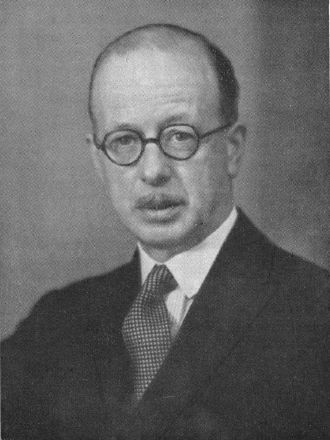 |
|
Philip Geoffrey Doyne
|
31 October 1886, in Headington
district, Oxfordshire, England
Robert Walter
Doyne
Gertrude Irene Hope (Hollings) Doyne
Winchester College, then Trinity
College, Oxford and St. Thomas's Hospital. He graduated B.M., B.Ch. in 1913
and in the following year obtained the F.R.C.S.
Winchester College register 1836-1906 p594
ed. John Bannerman Wainewright (1907)
DOYNE, PHILIP GEOFFREY (G),
b. 31 Oct., 1886, s. of Robert Walter Doyne, Esq., F.R.C.S., 53, Broad
St., Oxford, and Gertrude Irene Hope, his wife, d. of John Hollings, Esq.
(bro. of Humphry Cathair, below, p. 613).
Trin. Coll. Oxon 1904. Address
as above Evelyn Ida Griffin on 3 August 1915, in Chelsea
district, London, England. Evelyn was born on 25 July 1885, the
daughter of Marten Harcourt Griffin and Isabella Elizabeth Spencer. She died
on 6 May 1981, aged 95.
Ophthalmologist
After holding a number of resident appointments at St. Thomas's, including
that of ophthalmic house-surgeon, Philip joined the R.A.M.C. and served for
two and a half years as an ophthalmic specialist (with the rank of captain)
to the Middle East Force in Bagdad. After the war he returned to the
appointment of ophthalmic registrar at St. Thomas's, and a little later was
elected ophthalmic surgeon to the East London Hospital for Children. At the
Royal London Ophthalmic Hospital he first held the Lang research scholarship
and was then appointed to the staff as assistant surgeon, becoming in due
course full surgeon and senior surgeon. Elected to the honorary staff of St.
Thomas's Hospital on the retirement of Mr. J. H. Fisher, he was for a time
sub-dean of the medical school, and from 1935 to 1946 he was head of the
ophthalmic department. Philip took a special interest in children's eyes and
for many years he was also ophthalmic surgeon to the Hospital for Sick
Children, Great Ormond Street.
Philip's publications include Artificially
Induced
Ophthalmia (British Journal of Ophthalmology
1919 pp313-5), Coloured
Vision (Proceedings Royal Society of Medicine
Section of Ophthalmology 1922 p29), Amaurosis in Infants (Lancet
22 September 1922 pp607-8) Tournay's
Reaction (British Journal of Ophthalmology
1923 pp420-1), Ocular
Torticollis (Proceedings Royal Society of
Medicine Section of Ophthalmology 1929 p42); Syphilitic
Diseases of the Eye (British Journal of
Venereal Diseases 1930 219 p223) and Some
Cases
of Paralytic Squint (British Journal of
Ophthalmology 1937 pp531-4)
Philip was an accomplished fencer. He was twice amateur
foils
champion of Great Britain (in 1912 and 1920), and represented
Britain
at the Olympic Games in Antwerp in 1920 and Paris in 1924. Philip also
rowed at Henley Regattas, representing Trinity College in the Ladies' Plate
and Thames Cup in 1906, and Wyfold Fours in 1907 (Henley races p459)
22 January 1959, at his home at Assenden,
near Henley-on-Thames, Oxfordshire, England, aged 72
British Medical Journal 31 January 1959 pp305-6
Obituary
P. G. DOYNE, B.M., F.R.C.S.
Mr. P. G. Doyne, consulting ophthalmic surgeon to
St. Thomas's Hospital, Moorfields Eye Hospital, and the Hospital for Sick
Children, died at his home at Assenden, near Henley-on-Thames, on January
22. He was 72 years of age.
Philip Geoffrey Doyne was born on October 31, 1886, the son of Mr.
R. W. Doyne, F.R.C.S., the founder of the Oxford Eye Hospital and of the
Oxford Ophthalmological Congress. Educated at Winchester, Trinity College,
Oxford,
and St. Thomas's Hospital, he graduated B.M., B.Ch. in 1913 and in the
following year obtained the F.R.C.S. After holding a number of resident
appointments at St. Thomas's, including that of ophthalmic house-surgeon,
he joined the R.A.M.C. and served for two and a half years as an
ophthalmic specialist to the Middle East Force in Bagdad. After the war he
returned to the appointment of ophthalmic registrar at St. Thomas's, and a
little later he was elected ophthalmic surgeon to the East London Hospital
for Children. At the Royal London Ophthalmic Hospital he first held the
Lang research scholarship and was then appointed to the staff as assistant
surgeon, becoming in due course full surgeon and senior surgeon. Elected
to the honorary staff of St. Thomas's Hospital on the retirement of Mr. J.
H. Fisher, he was for a time sub-dean of the medical school, and from 1935
to 1946 he was head of the ophthalmic department. He took a special
interest in children's eyes and for many years he was also ophthalmic
surgeon to the Hospital for Sick Children, Great Ormond Street.
Mr. Doyne served on the Ophthalmic Group Committee of the B.M.A.
from 1938 to 1945. When the Association held its Annual Meeting at Bath in
1925 he acted as one of the honorary secretaries of the Section of
Ophthalmology, and at Dublin in 1933 he was a vice-president of the
Section. During the second world war he worked exceedingly hard in the
Emergency Medical Service, living in rooms so as to be within easy reach
of the hospitals to which he was attached. In 1943 he was elected master
of the Oxford Ophthalmological Congress, of which his father had been the
first master. When he retired in 1946 he went to live at Henley-on-Thames.
Although an ophthalmic surgeon of distinction, with a well-deserved
reputation for the soundness of his judgment, Doyne was of a very modest
disposition and he made few contributions to the literature of his
specialty. It often came as a surprise to his students to learn that he
had been one of the greatest amateur fencers of his day. He represented
Britain in the Olympic Games before the first world war, and he was twice
amateur foils champion of Great Britain.
Mr. Doyne leaves a widow and one daughter. His son-in-law, Emrys
Lloyd, also fenced for Great Britain at the Olympic Games and is a British
amateur foils champion.
Mr. G. G. PENMAN writes: By the death of Geoffrey
Doyne we lose another of that brilliant band of ophthalmologists who
flourished between the wars. He may be said to have been cradled in Oxford
ophthalmology, for his father was Robert Doyne, the great Oxford
ophthalmologist, who founded the Oxford Ophthalmological Congress, which
this year celebrates its fiftieth anniversary. It is sad that his son did
not live to see, and enjoy in good health, this occasion. At his house at
Bix, which he loved so much, Doyne was very close to Oxford. He was a
master of his craft, with a fine pair of hands, a keen diagnostic sense,
and a great store of knowledge. To his patients he was kindness itself,
and his experience at Great Ormond Street showed itself in his gentleness
with children and in his ability to obtain their confidence. In his
teaching his clear and simple demonstrations and logical thought, with his
wide acquaintance with the literature, were of the greatest value to all,
from the undergraduate student to the senior registrar.
As a man and as a colleague, Doyne was the kindest and friendliest
of persons. He was always helpful and cheerful, with a quiet sense of
humour, and never spoke an unkind word. The long and distressing illness
which struck him at about the time of his retirement from hospital work
deprived his friends of many years in which in the ordinary way they would
still have seen much of him and enjoyed his companionship, which they
sorely miss. Doyne was a fencer of international class, and when he gave
up actively competing he continued to take a great interest in this sport.
In this he followed his father, and his son-in-law continued the family
tradition. He also enjoyed his garden at Bix, and played a steady game of
golf on occasion. He loved his family and his home, and to his wife and
daughter all his friends will tender their sincerest sympathy.
and in British
Medical Journal 14 February 1959 pp446
P. G. DOYNE,
B.M., F.R.C.S.
T. M. T. writes: Many will have read with sorrow
the obituary of Mr. P. G. Doyne in the Journal
of January 31 (p. 305), especially his ex-house-surgeons, who must be
distributed all over the English-speaking world. It is not often that it
can be said of a man that everybody with whom he came in contact went away
with something of his personality imprinted on them. I am sure that every
one of those fortunate persons will join with me in expressing sympathy
with his widow and her daughter in their sad loss and spare a moment to
remember him on his passing.
British
Journal of Opthalmology (1959) p255-6
OBITUARY
PHILIP GEOFFREY
DOYNE
Progressive and harrowing ill health had
taken Geoff Doyne from the company of his friends for a number of years.
But many, especially those who knew him in London and Oxford, will have
been saddened by the news of his death.
Philip Geoffrey Doyne was born in 1886, the elder son of Robert
Doyne, whose name is esteemed in ophthalmological circles all over the
world. He was educated at Winchester, Trinity College, Oxford, and St.
Thomas's Hospital, from which he qualified in 1913 following this by his
F.R.C.S. (Eng.) in 1914. He served with the R.A.M.C. in the 1914-18 war
and spent three years in Mesopotamia, becoming the Army Eye Specialist in
Baghdad. He settled in London after the war and in due time was appointed
ophthalmic surgeon to St. Thomas's Hospital and surgeon to the Royal
London Ophthalmic Hospital (Moorfields). For a number of years he was
ophthalmic surgeon to the Hospital for Sick Children, Great Ormond Street.
He was an examiner for the Diploma in Ophthalmology at Oxford for some
years before the university discontinued the examination.
He was of retiring nature and wrote and spoke little in medical
circles, but was known to his colleagues and patients as a conscientious,
kind, and sound ophthalmologist whose work and opinion were held in high
regard. He became a Vice-President of the O.S.U.K., but a major affection
was for the Oxford Congress founded fifty years ago by his father. Of this
he was Master in the years immediately after the 1939-45 war and his
delightful company there and advice on the Congress Council over the years
will be remembered by many of his colleagues in Great Britain and
overseas. His modest, gentle charm, his slightly diffident merry wit, and
his hospitality endeared him to all who knew him.
He was fond of games, he rowed in his College boat, and with his
brother, especially when in later years he lived outside Henley, he kept a
keen interest in rowing all his life. But his major athletic interest
which brought him international fame was in fencing, for he was twice
British Amateur Foils Champion and was in the Olympic team for that
weapon. His fairness, skill, and courage brought honour and many demands
for service as fencer, judge, and adviser. He kept fit enough to fence
regularly till the age of sixty and enjoyed the company of a wide circle
of friends.
To his widow, his quiet but stalwart support, and to his daughter,
his many friends extend their most real sympathy.
1907: 53 Broad St, Oxford, Oxfordshire (Winchester College register 1836-1906 p594)
Philip Denys Doyne
28 October 1891, in Horningsham,
Wiltshire, England
29 November 1891, in St John
the Baptist, Horningsham, Wiltshire, England. Philip Denys Doyne is the son
of Philip Valentine Doyne, a clerk in holy orders residing in Horningsham,
and Mary Elizabeth.
Philip Valentine Doyne
Mary Elizabeth (Johnson) Doyne
Lancing College, Sussex, then
Keble College, Oxford, matriculating in 1910 and obtaining his B.A. in 1913
Philip was a schoolmaster at Winchester House, Deal, Kent, for a year after
graduating. He was about to start at Ely Theological College, studying to be
a clergyman, when the First World War broke out, and instead he volunteered
to serve immediately. Philip had been in the Officers' Training Corps at
Oxford (The O.T.C. and the Great War p140) and
commenced his service in September 1914. He served as a Lieutenant in the
2/4th Battalion of the Oxfordshire & Buckinghamshire Light Infantry, and
was promoted temporary Captain on 11 December 1914. He went to the
front on 3 August 1915, and on being posted to the 1/4th Battalion
relinquished his temporary rank (London Gazette 7 September 1915 p8981)
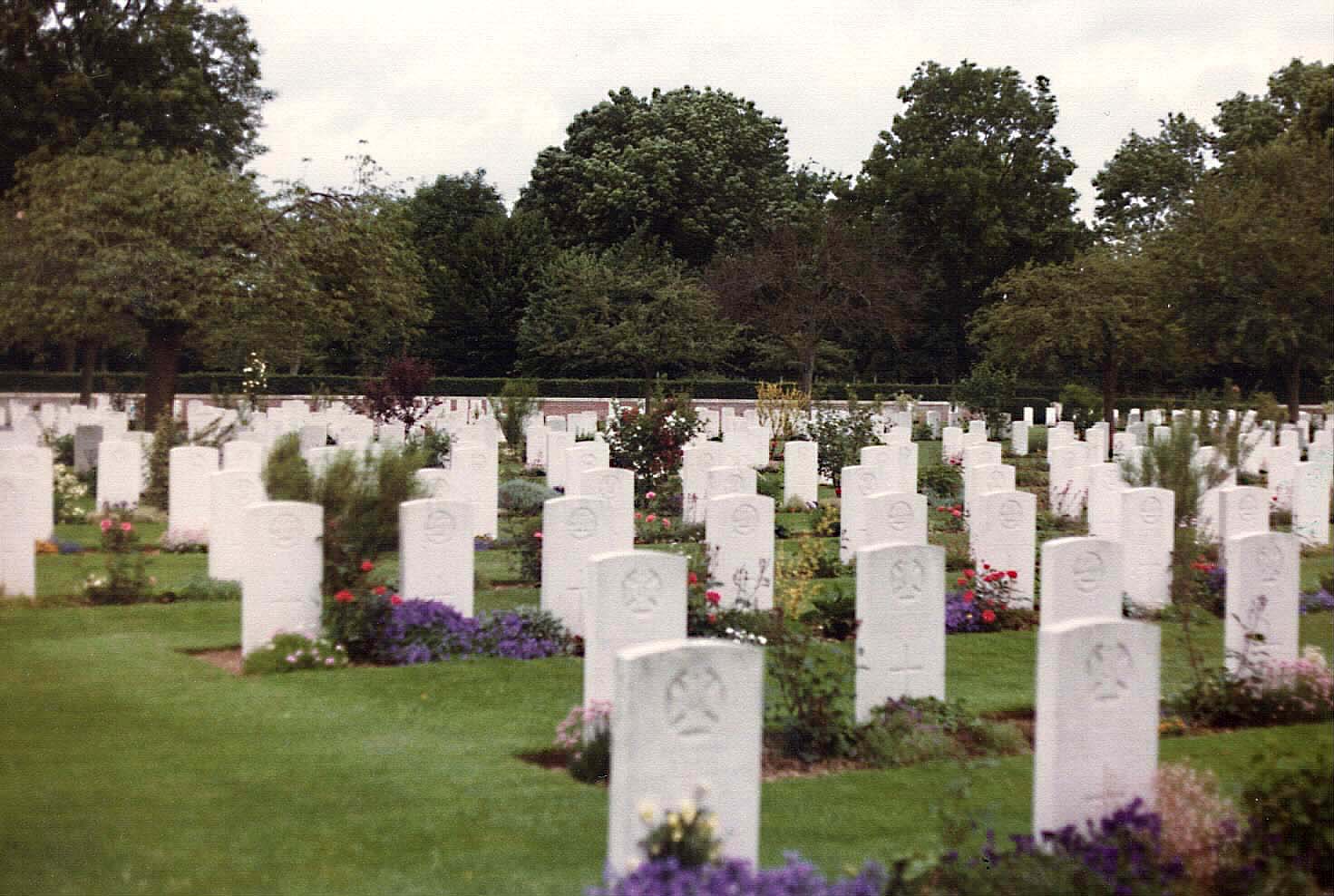
|
|
Hebuterne Military Cemetery, where Philip
is buried
|
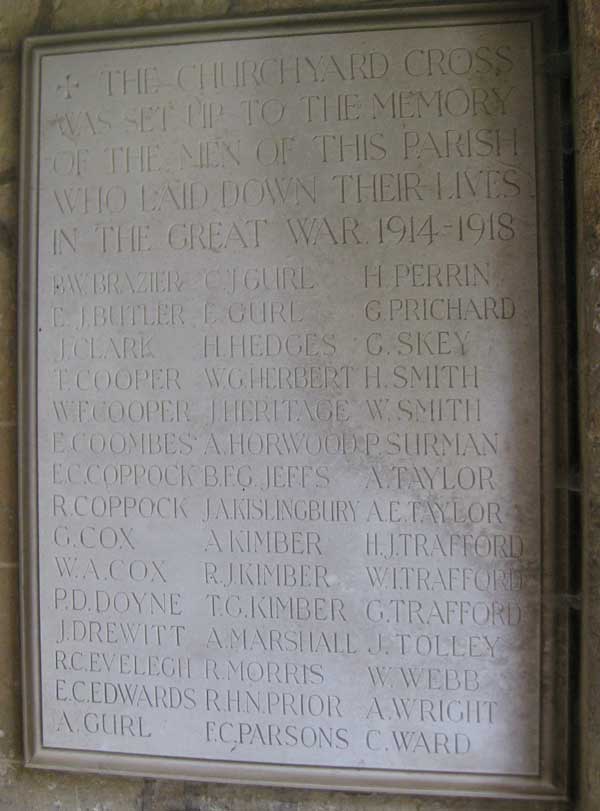
|
|
Memorial inscription in the porch of
Headington Quarry church, which includes Philip's name
|
28 December 1915, in Hébuterne,
Pas-de-Calais, France, aged 24. Just after returning from leave, Philip was
shot when out with a patrol in Hébuterne.
Hébuterne Military Cemetery,
Hébuterne, Pas-de-Calais, France (Grave reference I.D. 9). Philip is
memorialised on the War
memorial
in Holy Trinity churchyard in Headington Quarry, Oxfordshire and on a
memorial
in
Keble College, Oxford.
1901: Beckley Vicarage, Beckley, Oxfordshire
1911: Beckley Vicarage, Beckley, Oxfordshire
Robert Walter Doyne
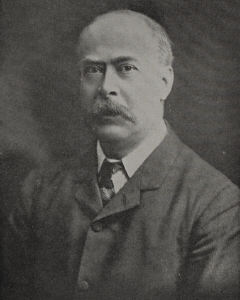 |
|
Robert Walter Doyne.
This photograph was clearly the source for the striking of the
Doyne memorial medal shown below.
|
15 May 1857, in Monart, county
Wexford, Ireland
Philip Walter Doyne
Emily
Sophia (Richards) Doyne
Marlborough College, Wiltshire,
then Keble College, Oxford where he matriculated in 1875, but did not finish
due to illness. He then entered the Bristol Medical School, and later on St.
Georges Hospital, London. He obtained the diploma of M.R.C.S., and then the
diploma of F.R.C.S.Eng.
on
8 December 1892. The honorary degree of M.A. was conferred upon him by
Oxford University in 1903.
Robert attended Marlborough at the same time (and was on the Rifle Corps XI
at the same time) as Arthur Edward Finch, the future husband of his sister,
Charlotte Doyne.
Marlborough College register p233 (1905)
Doyne Robert
Walter, s. of the late Rev. P.W. Doyne, care of Mrs. Doyne,
Monant, Torquay, b. May 15, 1857; l. Easter 1875. B 1
R.W. Doyne, Esq. 53
Broad Street Oxford
R.C. XI. 1873-4; M.R.C.S. Eng. 1880; F.R.C.S Eng. 1892; M.A. Oxf. Honoris causa 1903; St. George's
Hosp. formerly Surg. R.N.; Consulting Ophth. Surg. Radcliffe Infirm.,
Oxf.; Sen. Surg. Oxf. Eye Hosp.; Surg. Royal Eye Hosp. Lond.; Reader in
Ophthalmology Oxf. Univ.; Author: The
more Common Diseases of the Eye
Alumni Oxoniensus 1715-1886 vol 1 p385
(1891)
Doyne,
Robert Walter, 2S. Philip Walter, cler. KEBLE
COLL matric. 18 Oct., 1875, aged 18.
Gertrude Irene Hope Hollings on 7
July 1885 in Hampstead
district, Middlesex, England. Gertrude was born in 1864 in Bradford
district, West Riding of Yorkshire, the youngest daughter of John
Hollings, of The Watchetts, Frimley, Surrey.
1881:
30
Priory Road, London, Middlesex
Ophthalmologist. Robert was, for
a short period, a naval surgeon, joining the service on 21 August 1883 (London Gazette 25 August 1883 p4227), and
posted to the Temeraire as surgeon
on 1 April 1884 in time for its re-commission in Malta. (Royal Navy List 1884 p188). He resigned his
commission upon his marriage in 1885. When Robert settled in Oxford in 1885
there were no facilities in the city for the treatment of ocular disease;
Doyne led a committee that established the Oxford Eye Hospital in 1886 in
which Robert worked for over 25 years, resigning the post of senior surgeon
at the hospital in 1912. Mr. Doyne was consulting ophthalmic surgeon to the
Radcliffe Infirmary and surgeon to the Royal Eye Hospital, London. In 1902
he became the first reader in ophthalmology to the University of Oxford, a
post which he held for eleven years. In 1909 the Oxford Ophthalmological
Congress was founded with Doyne as the first Master, an annual meeting which
has since become
one
of the features of British and world ophthalmology.
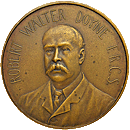
|
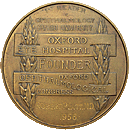
|
|
Robert Walter Doyne: Posthumous
commemorative medal struck in bronze 1917 (Spink & Sons)
|
The respect with which he was held was epitomized by the establishment of
the Doyne Memorial Lecture and Medal two years after his death, still one of
the most prized distinctions of British Ophthalmology.
Robert was an acute and accurate clinical observer and one of the several
conditions he first described was named Doyne's honeycomb choroiditis. This
is the occurrence of colloid bodies (drusen) observed to lie on Bruch's
membrane in certain families who lived in Oxford, England. These drusen
tended to merge together and eventually become confluent, resembling a
honeycomb. Today this condition is known to be a rare hereditary form of
macular degeneration which results in progressive and irreversible loss of
vision, and goes by several names such as macular drusen, malattia
leventinese, dominant radial drusen and Doyne honeycomb retinal dystrophy.
Mr. Doyne was the author of a book entitled Notes
on the More Common Diseases of the Eye (1896), and of papers on
Treatment of Atrophic Retinae with Retinal Extract (British Medical Journal 25 July 1903 p190)
Conjunctivitis (Lancet, 1910); Visual
Sensation, Perception, Appreciation, and Judgement (Ophthalmoscope,
1910); Retinitis Pignentoss (ibid., 1910); The Value and Misuse of
Spectacles in Treatment of Headache, Migraine, and other Functional Troubles
of the Eyes (British
Medical Journal 13 August 1910 pp361-5); Description of
Hitherto Undescribed Forms of Iritis, Family Choroiditis, and Conjunctivitis
(Trans. Ophth. Soc., 1910); and "Eye" in
Sport (British
Medical Journal 24 December 1910 p1960).
30 August 1916, in Oxford,
Oxfordshire, England
Holy Trinity Church, Headington
Quarry, Oxfordshire, England
British
Medical Journal 16 September 1916 pp409-10
OBITUARY.
R. W. DOYNE, M.A.OXON., F.R.C.S.,
CONSULTING OPHTHALMIC SURGEON,
RADCLIFFE INFIRMARY,
OXFORD.
WITH great regret we announce the
death of Mr. R. W. Doyne, of Woodstock Road, Oxford. He was the son of the
Rev. Philip Walter Doyne, and was born at Monart, co. Wexford, in 1857. He
was educated at Marlborough, and matriculated at Keble College in 1875.
Illness prevented his remaining at Oxford, and on leaving he entered the
Bristol Medical School, and later on St. Georges Hospital. He obtained the
diploma of M.R.C.S., and was for a short time in practice in Bristol. In
1883 he joined the navy, but left it in 1885 on his marriage, and settled
in Oxford. He took the diploma of F.R.C.S.Eng. in 1892, and the honorary
degree of M.A.Oxon. was conferred upon him in 1902.
From the outset of his life in Oxford he made a special study of
ophthalmology. Beginning in a very small way, with an eye dispensary in a
builder's yard, he worked steadily on, encouraged by the loyal support of
many good friends, among whom were Sir Henry Acland, Dr. Liddell, of
Christ Church, Bishop Paget, Dr. Talbot, the Warden of Keble, and others.
Soon the committee rented on a long lease buildings from the County
Hospital, and so the Oxford Eye Hospital grew little by little, till it
became one of the best known and most useful institutions in the Midland
counties. In 1912, after more than twenty-five years' continuous service,
Mr. Doyne resigned, the post of senior surgeon to the Oxford Eye Hospital,
and many of his personal friends and admirers seized the opportunity of
connecting his name permanently with the institution by placing within its
walls an excellent marble bust with an inscription commemorating his
services.
Mr. Doyne was consulting ophthalmic surgeon to the Radcliffe
Infirmary. He was also the first reader in ophthalmology to the University
of Oxford, a post which he held for eleven years. He was surgeon to the
Royal Eye Hospital, London. It was due to his energy that there was
started in Oxford a congress of ophthalmologists, which has for years met
with such unqualified success, and which has attracted to its
discussions some of the most eminent ophthalmologists from every part of
the world. For many years Mr. Doyne was the leading spirit of these
gatherings. He proved himself a most genial and kindly host, and the
success of these meetings depended very largely on the care, forethought,
and power of organization he had expended on the arrangements for them.
Consequently when ill health prevented his attending the last two
gatherings, his work was not forgotten, and formal expressions of regret
and sympathy were forwarded to him from the members of the congress
present.
To his skill as an ophthalmic surgeon many would be glad to
testify. His boundless generosity to patients in needy circumstances was
well known to some of his intimate friends. His death at a comparatively
early age was due very largely to the intensity of energy he threw into
any project he took up, and the scant amount of rest he allowed himself.
It was especially owing to this superabundant energy that he bore down the
opposition he met with from time to time in carrying out the numerous
enterprises connected with his name.
Mr. Doyne was the author of a book entitled The
More Common Diseases of the Eye, and of papers on
Conjunctivitis (Lancet, 1910);
Visual Sensation, Perception, Appreciation, and Judgement (Ophthalmoscope,
1910); Retinitis Pignentoss (ibid., 1910); The Value and Misuse of
Spectacles in Treatment of Headache, Migraine, and other Functional
Troubles of the Eyes (BRITISH MEDICAL JOURNAL,
1910); and Description of Hitherto Undescribed Forms of Iritis, Family
Choroiditis, and Conjunctivitis (Trans.
Ophth. Soc., 1910).
In private life it would be difficult to meet with a more generous
friend than Mr. Doyne. In his periods of relaxation he delighted to gather
his friends round him, and would do everything in his power to make them
enjoy themselves. One of his chief amusements was fencing, and he was the
founder of the Oxford Fencing Club.
Mr. Doyne leaves a widow and two sons, one of whom, a captain
R.A.M.C.(T.), is serving in Mesopotamia.
Sir ANDERSON CRITCHETT writes:- The malady
which overtook our late colleague, Robert Doyne, about three years ago
suddenly dimmed an exceptionally bright intelligence, and closed a most
promising professional career, but before the blow fell time and
opportunity had been afforded him to associate his name with work which
must have permanent record. He initiated and brought to a high level of
success the Oxford Ophthalmological Congress, and, owing to the deservedly
high esteem in which he was held by the authorities, he secured the
establishment of a diploma in ophthalmology in connexion with the
University of Oxford. Had fate permitted, his marked ability and firm
tenacity of purpose might have brought yet further achievement; but now we
mourn the loss of an able colleague and a generous friend.
The Ophthalmic Year Book vol 13 p419
ed. Edward Jackson (1916):
DOYNE, ROBERT WALTER,
born at Monart, County Wexford, Ireland, 1857, died at Oxford, England,
August 30. He was educated at Marlborough, Keble College, Oxford, the
Bristol Medical School and St. George's Hospital, London. He soon entered
the medical services of the navy, but in 1885 settled in Oxford and
devoted himself to ophthalmology. At that time there was neither
ophthalmic surgeon nor clinic in the city. Even at the County Hospital
there was no dark room, no test types, and no special appliances. After
many difficulties and strenuous opposition, Doyne founded the Oxford Eye
Hospital. In 1902 he was appointed the first Reader in Ophthalmology in
the University of Oxford - a post he continued to hold until his health
broke down three years ago. He was also consulting ophthalmic surgeon to
the Radcliffe Infirmary, surgeon to the Royal Eye Hospital, London, and
held besides a number of minor appointments.
His name is associated with several conditions, as, for example, a
congenital variety of cataract known as "Doyne's" or "discoid cataract"; a
peculiar kind of degeneration of the choroid called "Doyne's" or "family
choroiditis"; a form of inflammation of the iris "guttate" or "Doyne's
iritis," and of conjunctivoblepharitis "Doyne's conjunctivitis." He was
the author of "The More Common Diseases of the Eye" (1896). Doyne presided
over the section on Ophthalmology at the annual meeting of the British
Medical Association held at Oxford in 1904. After this summer gatherings
of ophthalmologists developed under his influence into the Oxford
Ophthalmological Congress, of which he was the first "Master" in 1910. For
many years he conducted at Oxford courses in ophthalmology for
practitioners, and was mainly instrumental in inducing the University of
Oxford officially to recognize eyework by instituting a Diploma in
Ophthalmology (19100. - Ophthalmoscope,
Vol. 14, p. 563
The Toronto World 12 September 1918 p5
(Toronto, Ontario, Canada)
WILLS
PROBATED
Robert Walton Doyne, who died at his home,
121 Woodstock road, Oxford, England, Aug., 1916, left an estate valued at
$90,447, and Mrs. Gertrude Irene Hope Doyne, Oxford, England, widow, who
is sole beneficiary and executrix, has applied for ancillary probate of
the will. The Ontario estate consists of 71 shares Brazilian, valued at
$4,410, and 140 Crown Reserve valued at $65. On 15 March 1879, Robert was made a Second Lieutenant in
the 1st Somersetshire Engineer Volunteer Corps (London Gazette 14 March 1879 p2141).
Who's Who p506 (1907)
DOYNE
Robert Walter, M.A. Oxon.; F.R.C.S.; Consulting Ophthalmic
Surgeon, Radcliffe Infirmary, since 1900; Reader in Ophthalmology,
University of Oxford, since 1902; Senior Surgeon Oxford Eye Hospital;
Surgeon Royal Eye Hospital, London; Ophthalmic surgeon S. John's Hospital,
Cowley; b. 15 May 1857; 2nd s. of late Rev. P.W. Doyne; m.
Gertrude Irene Hope, y.d. of
late John Hollings. Educ.:
Marlborough; Keble College, Oxford. After qualifying, travelled; then
entered navy, which he left on marriage; founded Oxford Eye Hospital. Publication: The More Common Diseases
of the Eye; Retinal Extract on the Treatment of Atrophic Retinae; several
papers. Recreation: fencing. Address: 34 Weymouth Street, W.; 53
Broad Street, Oxford. Club:
Royal Societies.
1871:
Marlborough College, Marlborough, Wiltshire
1881:
Home
Villa, Fishponds Rd, Stapleton, Gloucestershire
1883: Somerset Villa, Fishponds, Stapleton, Gloucestershire (Kelly's 1883 Directory of Somersetshire)
1895: 64 St Giles, Oxford, Oxfordshire (British Medical Journal 6 July 1895 p55)
1907: 53 Broad St, Oxford, Oxfordshire (Winchester College register 1836-1906 p594)
1916: 121 Woodstock Road, Oxford, Oxfordshire (The Toronto World 12 September 1918 p5)
Return to Chris Gosnell's Home Page
If you have any comments, additions or modifications to the information on this page, please feel free to email me.
Created and maintained by: chris@ocotilloroad.com








